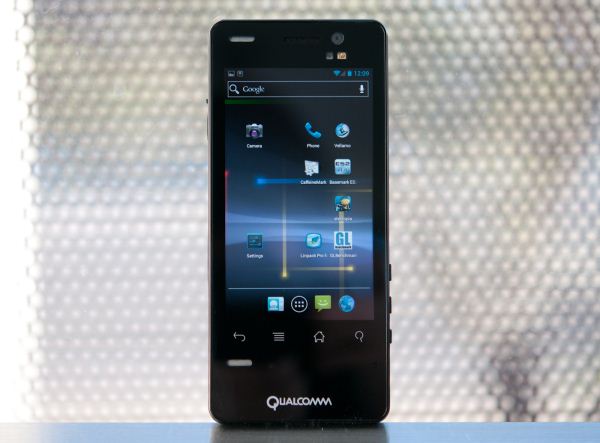Qualcomm Snapdragon S4 (Krait) Performance Preview - 1.5 GHz MSM8960 MDP and Adreno 225 Benchmarks
by Brian Klug & Anand Lal Shimpi on February 21, 2012 3:01 AM EST- Posted in
- Smartphones
- Snapdragon
- Qualcomm
- Adreno
- Krait
- Mobile
Final Words
It goes without saying that MSM8960 is a hugely important SoC release for Qualcomm. It's the first release with Qualcomm's new Krait CPU architecture, an entirely new cellular baseband with support for nearly every air interface, and is manufactured on TSMC's 28nm process. It says something that we're able to hold 28nm TSMC silicon in our hands in the form of the MDP, and it's only a matter of time before we start seeing Krait show up in devices in 2012.
We've gone over basically all of the benchmarks available to us on Android right now, and yet subjective performance impressions are still valuable. The MDP8960 is the absolute fastest we've seen Ice Cream Sandwich thus far - the UI is absolutely butter smooth everywhere, and web browsing in either Chrome or the stock Android Browser is also the smoothest we've seen it. There's no stutter bringing up the application switcher, or taking screenshots, two places that 4.0.3 still drops frames on the Galaxy Nexus.
Krait offers another generational leap in mobile SoC performance. The range of impact depends entirely on the workload but it's safe to say that it's noticeable. The GPU side of the equation has been improved tremendously as well, although that's mostly a function of 28nm enabling a very high clock speed for Qualcomm's Adreno 225. We are eager to see what the Adreno 3xx GPUs that will pair up with future Krait SoCs can do.
The big unknowns today are power consumption and the performance of shipping devices. While we were able to provide power numbers using Qualcomm's handy Trepn tool, we couldn't produce a reference point on older silicon. The move to 28nm and a second generation of cellular basebands has generally been heralded as being the answer to our battery life issues, particularly with LTE. It remains to be seen just how much of an improvement we'll see there. Knowing how much power MSM8960's cellular architecture uses is especially relevant when you consider that MDM9615 includes the exact same modem as MSM8960.
These initial results look extremely promising, however. Krait based devices should begin shipping sometime next quarter, the wait is almost over.











86 Comments
View All Comments
nbenedetto1998 - Tuesday, January 1, 2013 - link
Krait is a15 just built on the a9 nm process which is 32 nm I believe. The real A15 will be built on a 28nm process.sjael - Tuesday, February 21, 2012 - link
Would be great to put some Transformer Prime numbers next to it. You know, just for kicks...infra_red_dude - Tuesday, February 21, 2012 - link
Some numbers where it beats Tegra3 everywhere (almost):http://www.pcmag.com/article2/0,2817,2400409,00.as...
Loki726 - Tuesday, February 21, 2012 - link
I'd like to see a clock-for-clock comparison. Tegra 3's A9 is at 1.3ghz and Krait is at 1.5ghz here. I'd be interested to see what happens when A9 gets scaled down to 28nm, and whether or not Krait will still have an advantage.Wishmaster89 - Wednesday, February 22, 2012 - link
And what would you need 1.5Hhz A9 for at 28nm? A15 is much better than any A9, and will come at lower process nodes.Besides, you can see that 1.2Ghz Exynos is much slower than 1.5Ghz Krait so I don't think higher clock will change it.
LordConrad - Tuesday, February 21, 2012 - link
I want one of these in my next phone. My HTC Thunderbolt works great, but it's getting a bit dated.TedKord - Tuesday, February 21, 2012 - link
Being an Anandtech reader, you've gotta be rooted and have a custom rom slapped on. What do you have flashed on yours?LordConrad - Wednesday, February 22, 2012 - link
Right now I'm using the BAMF Forever ROM, nice features and very stable. I'll stick with it until I find something better (or get a new phone).ShieTar - Tuesday, February 21, 2012 - link
"At a lower resolution Apple's A5 is unable to outperform the Adreno 225 here."Actually, 960x640 and 1024x600 both have exactly the same number of total pixels.
Not that it changes the conclussion.
lowlymarine - Tuesday, February 21, 2012 - link
"At a lower resolution Apple's A5 is unable to outperform the Adreno 225 here."Perhaps I'm misreading this line, but aren't 1024x600 and 960x640 actually exactly the same resolution in different aspect ratios?